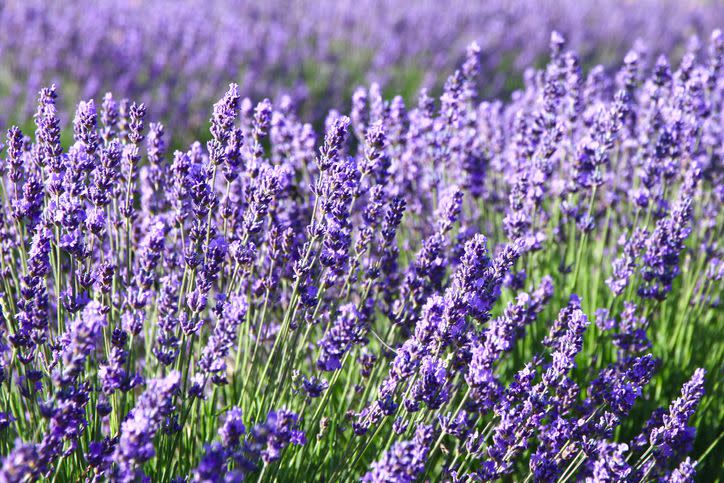When Does Lavender Bloom? A Guide to Peak Blooming Season

Caroline Gauvin / Getty Images
Lavender, Lavandula spp., can be a little tricky to grow and finicky about its care. But this highly aromatic, versatile herb is not only a commercial crop for the perfume, soap, and fragrance industries.
It's highly valued by gardeners everywhere in herb gardens, flower gardens, pots, and borders for its delicate, spiky flowers and sweet fragrance.
Whether you plant lavender simply for its beauty and scent or to harvest for use in your home, there are ways to get the best, biggest, and greatest number of buds and flowers.
Here are tips to get started on a bountiful lavender harvest.
Lavender Blooming Seasons
Most lavenders bloom during the annual summer growing season. Depending on the variety, blooms may appear anywhere from early to late in the season and can even produce continuous blooms all season long. Common types of lavender are English, Spanish, French, and Portuguese.
English Lavender, Lavandula augustifolia: 'Hidcote' and 'Munstead.' are two of the most popular English cultivars. Bloom times depend on types and pruning practices. However, most bloom early to mid-season beginning in June or July lasting three to four weeks. Early blooms may be followed by a full flush if the plant is lightly pruned after the first bloom. Some English cultivars also produce a second smaller bloom in late summer.
Spanish Lavender, Lavandula stoechas: Spanish lavender, also known as Butterfly lavender, produces the showiest flowers with two blooms above each stalk resembling butterfly wings or rabbit ears. L. stoechas begins blooming in early May in warm climates with mild winters. A more generous bloom follows in June and a third but smaller bloom in August or early autumn.
French Lavender, Lavandula dentata: Hardy only in zones 8 and 9, French lavender is grown as an annual in lower zones. In warm climates, it blooms continuously from early summer through autumn and can bloom year-round in its hardiness zones. Though less fragrant than other lavenders, the toothed foliage gives this lavender its distinctive look.
Portuguese Lavender, Lavandula latifolia: Also called Spike lavender is identified by broad evergreen leaves and strong scent. It blooms continuously from late spring to late summer in zones 6 through 8.
How to Maximize Lavender's Blooms
Pruning
Pruning lavender plants correctly is essential, not only to maximize bloom and harvest, but also to extend the life of your plants. During the growing season, pruning and harvesting are one and the same.
Remove blooms down to the first set of leaves even if you find only a few on the plant. Do not cut into the woody part of the stem. This moves everything forward to a fuller second flush.
Keep in mind it can take certain varieties up to three years to produce a substantial harvest. Be patient.
Plants need to be hard pruned annually by up to one-third of the plant size. This can be done at the end of the growing season once temperatures have dropped and directs energy back into the roots. Late autumn pruning is especially helpful for young plants with undeveloped shallow root systems.
Hard pruning in spring encourages new growth. Wait to cut back until you see new growth at the base. Early spring pruning encourages new green growth and works best with mature plants.
Fertilizer and Watering
Too much fertilizer can lead to a reduction in blooms. Feeding in early spring with bone meal, blood meal, or kelp can benefit young plants, but lavender generally thrives in poor soil as long as the pH is slightly alkaline.
These aromatics do not tolerate wet feet. Shallow roots easily rot if left to sit in water.
Plant in a location with good drainage or work sand into the planting bed. Mulch with a bed of pebbles to increase drainage around the roots and allow the soil to dry out between waterings.
What to Do if Your Lavender Plant Isn't Blooming
If your lavender isn't performing to expectations, check this list for potential problems and how to fix them.
Are you growing the right variety for your zone?
Is your plant at least two years old? Lavenders take up to three years to produce a good-sized bloom set and harvest.
Are you pruning all flowers after each bloom? This encourages more blooms. You should also be pruning your plant at least twice annually. Cut back up to one-third of the plant in late autumn to encourage root growth or one-third in early spring as soon as new growth appears at the base.
The plant has grown too woody. This is a problem caused by insufficient pruning. Restart a twice-annual program to reshape the plant removing all dead growth where no signs of green emerge in the spring. Continue pruning single blooms and cutting back green growth slightly during the season to promote healthier bushier foliage.
Eliminate fertilizer and allow your plants to dry out before watering.
Make sure your planting area drains well and soil pH is slightly alkaline.
Frequently Asked Questions
How many times does lavender bloom each year?
Lavenders perennial to warm climates can bloom all season and all year long. Other varieties often put up a few stems in early spring, followed by a fuller flush during the growing season and a smaller bloom in later summer or early autumn.
How do you extend the bloom time of lavender?
Proper pruning and providing the correct growing environment are all key to producing the best lavender blooms. Keep your variety blooming by giving the correct care and continue to remove flowers and stems with buds when spikes mature.
How do you get a lavender plant to bloom?
First, make sure you plant the right variety for your growing zone. Don't look for lots of flowers until the plant is at least two to three years old but continue to give it proper care and pruning throughout. Go easy on fertilizer and watering.
Read the original article on The Spruce.

